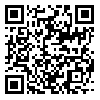دوره 7، شماره 1 - ( بهار و تابستان 1399 )
جلد 7 شماره 1 صفحات 77-61 |
برگشت به فهرست نسخه ها
دانشگاه علوم پزشکی خدمات بهداشتی درمانی ایران
چکیده: (5007 مشاهده)
مقدمه و هدف: انتخاب روش تدریس مناسب در رشته های بالینی مانند پرستاری به علت تعامل با بیمار دارای اهمیت بسیار است. پژوهش حاضر درصدد مقایسه دو روش آموزشی ایفای نقش و آموزش معمول بر یادگیری بلندمدت دانشجویان پرستاری است.
روشها: در این مطالعه نیمهتجربی 74 نفر از دانشجویان پرستاری دانشگاه علوم پزشکی ایران در سال 96-1395، به روش تصادفی ساده به دو گروه کنترل (35=n) و آزمون(39=n) تقسیم شدند. در گروه آزمون از روش ایفای نقش و در گروه کنترل، آموزش معمول استفاده شد. هر یک از دانشجویان در ترم بعدی، در بیمارستان به دو بیمار آموزش دادند. میزان رضایت بیماران از آموزش داده شده توسط دانشجو، به عنوان شاخصی برای یادگیری بلندمدت مورد سنجش قرار گرفت. 2 پرسشنامه اطلاعات دموگرافیک، و رضایتمندی مورد استفاده قرار گرفت. داده ها با استفاده از نرم افزار SPSS(V16) و آزمونهای آماری توصیفی و استنباطی مورد تجزیه و تحلیل قرار گرفت.
یافتهها:. نتایج نشان داد که روش آموزشی ایفای نقش موجب ارتقاء رضایتمندی بیماران از عملکرد دانشجویان در زمینه آموزش بیمار شده است. میانگین نمره رضایتمندی بیماران از عملکرد آموزش به بیمار دانشجویان گروه آزمون 26/73 %و گروه کنترل32/47 %بوده و از نظر آماری اختلاف معنی داری داشتند(001/0> P).
نتیجه گیری: یافتههای این مطالعه تاثیر آموزش به روش ایفای نقش بر یادگیری بلندمدت دانشجویان پرستاری را نشان داد.
روشها: در این مطالعه نیمهتجربی 74 نفر از دانشجویان پرستاری دانشگاه علوم پزشکی ایران در سال 96-1395، به روش تصادفی ساده به دو گروه کنترل (35=n) و آزمون(39=n) تقسیم شدند. در گروه آزمون از روش ایفای نقش و در گروه کنترل، آموزش معمول استفاده شد. هر یک از دانشجویان در ترم بعدی، در بیمارستان به دو بیمار آموزش دادند. میزان رضایت بیماران از آموزش داده شده توسط دانشجو، به عنوان شاخصی برای یادگیری بلندمدت مورد سنجش قرار گرفت. 2 پرسشنامه اطلاعات دموگرافیک، و رضایتمندی مورد استفاده قرار گرفت. داده ها با استفاده از نرم افزار SPSS(V16) و آزمونهای آماری توصیفی و استنباطی مورد تجزیه و تحلیل قرار گرفت.
یافتهها:. نتایج نشان داد که روش آموزشی ایفای نقش موجب ارتقاء رضایتمندی بیماران از عملکرد دانشجویان در زمینه آموزش بیمار شده است. میانگین نمره رضایتمندی بیماران از عملکرد آموزش به بیمار دانشجویان گروه آزمون 26/73 %و گروه کنترل32/47 %بوده و از نظر آماری اختلاف معنی داری داشتند(001/0> P).
نتیجه گیری: یافتههای این مطالعه تاثیر آموزش به روش ایفای نقش بر یادگیری بلندمدت دانشجویان پرستاری را نشان داد.
فهرست منابع
1. Hsieh SI, Hsu LL. An outcome-based evaluation of nursing competency of baccalaureate senior nursing students in Taiwan. Nurse education today. 2013;33(12):1536-45.
2. Choi YJ. Exploring experiences of psychiatric nursing simulations using standardized patients for undergraduate students. Asian nursing research. 2012;6(3):91-5.
3. Vernon R, Chiarella M, Papps E. Confidence in competence: legislation and nursing in New Zealand. International Nursing Review. 2011;58(1):103-8.
4. West C, Usher K, Delaney LJ. Unfolding case studies in pre-registration nursing education: Lessons learned. Nurse education today. 2012;32(5):576-80.
5. Dorri S, Hakimi H. The Effect of Mastery learning model for suction and oxygen therapy skills in nursing students. Research in Medical Education. 2018;9(4):10-19.
6. Shamsi A, Dorri S. The role of mastery learning on clinical education: a review. Strides in Development of Medical Education. 2018;15(2):139-50.
7. Xu JH. Toolbox of teaching strategies in nurse education. Chinese Nursing Research. 2016;3(2):54-7.
8. Pritchard SA, Blackstock FC, Nestel D, Keating JL. Simulated patients in physical therapy education: systematic review and meta-analysis. Physical therapy. 2016;96(9):1342-53.
9. Kucharčíková A, Ďurišová M, Tokarčíková E. The role plays implementation in teaching macroeconomics. Procedia-Social and Behavioral Sciences. 2015;174:2489-96.
10. Ross MET, Otto DA, Helton AS. Benefits of Simulation and Role-Playing to Teach Performance of Functional Assessments. Nursing education perspectives. 2017;38 (1):47-8.
11. Chan ZC. Role-playing in the problem-based learning class. Nurse Education in Practice. 2012;12(1):21-7.
12. Hekmatpou D, ANOUSHEH M, ELHANI F. Pathology of patient education: A qualitative study. Irab Journal of Nursing. 2007;20(49):51-60.
13. Zendejas B, Wang AT, Brydges R, Hamstra SJ, Cook DA. Cost: the missing outcome in simulation-based medical education research: a systematic review. Surgery. 2013;153(2):160-76.
14. Warland J, Smith C, Smith M. Much ado about the flu: Design and implementation of an e-role play for a large class of undergraduate students. Nurse Education in Practice. 2012;12(2):65-71.
15. Hunter C, Ravert PK. Nursing students’ perceptions of learning outcomes throughout simulation experiences. Undergraduate Research Journal for the Human Sciences. 2010;9(1).
| بازنشر اطلاعات | |
 |
این مقاله تحت شرایط Creative Commons Attribution-NonCommercial 4.0 International License قابل بازنشر است. |




